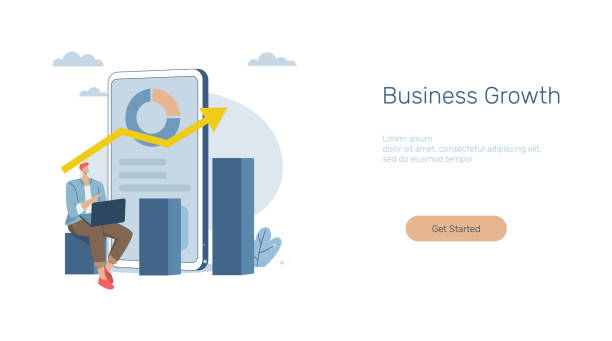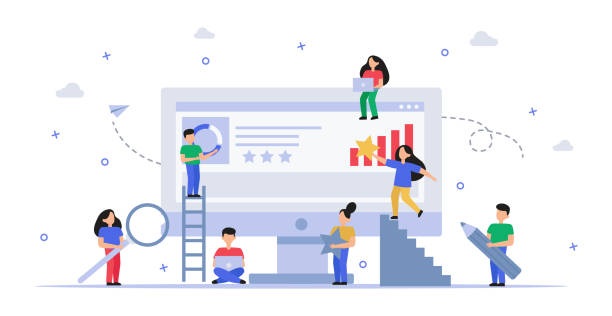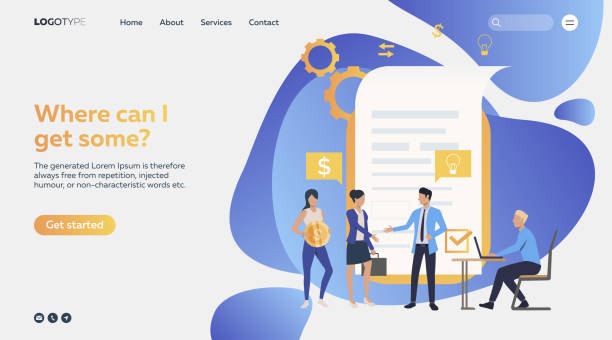Introduction to the Necessity of Multilingual Website Design

In today’s world, the boundaries of #commerce and #communications have increasingly faded due to the internet.
Any #business looking to grow and expand in #global_markets must inevitably utilize modern tools.
Among these, multilingual website design is no longer a luxury option, but rather a strategic necessity.
This approach allows you to connect with audiences from diverse cultures and languages and deliver your message to a larger number of people worldwide.
The goal of a multilingual website design goes beyond mere text translation; it means comprehensive localization of content, user experience, and even SEO approaches for each specific language and culture.
This helps businesses establish a stronger and more effective presence on the international stage and increase their competitiveness.
Having a website capable of presenting content in multiple languages not only increases audience reach but also boosts brand trust and credibility among them.
Are you tired of your e-commerce website not generating as much revenue as it could? Rasaweb, specializing in professional e-commerce website design, solves this problem permanently!
✅ Increased sales rate and revenue
✅ High loading speed and exceptional user experience
⚡ Get free e-commerce website design consultation
Challenges and Obstacles in Multilingual Website Design

Despite numerous advantages, implementing a multilingual website design presents its own challenges, requiring precise planning and specialized knowledge.
One of the most important obstacles is the issue of #accurate_translation and content localization.
Word-for-word translation is often insufficient and can lead to cultural misunderstandings or loss of original meaning.
Understanding subtle cultural differences, local idioms, and even humor is vital for each target language.
Another challenge relates to #technical_management and #multilingual_SEO.
How can URL structures be set up to be understandable to search engines? Using hreflang tags and managing sitemaps for each language are complex technical issues that must be correctly implemented.
Furthermore, #technical_support and #content_updates in multiple languages can become a time-consuming and costly endeavor.
Ignoring any of these challenges can lead to a decrease in the efficiency and effectiveness of a multilingual website and render the initial investment fruitless.
Therefore, before embarking on such a project, all aspects must be carefully reviewed and planned.
Technical Approaches to Implementing Multilingual Website Design and Their Solutions

When it comes to multilingual website design, choosing the right technical approach is of paramount importance.
There are three main methods for organizing language versions of a website: #subdirectories, #subdomains, and #separate_domains.
Each of these methods has its own advantages and disadvantages in terms of SEO, management, and hosting.
For example, using subdirectories (e.g., yoursite.com/en/) is often recommended for local SEO, as it shares the main domain’s authority.
In contrast, subdomains (e.g., en.yoursite.com) might be more suitable for larger projects and separate management of each language.
Separate domains (e.g., yoursite.co.uk) are also used for very specific targeting of a particular country or geographical region.
Additionally, using a powerful Content Management System (CMS) with built-in multilingual support or through plugins (such as WordPress with WPML, or Joomla and Drupal) plays a key role in simplifying the content development and management process.
These systems allow you to manage content for each language separately and easily switch between them.
| Approach | URL Example | Advantages | Disadvantages |
|---|---|---|---|
| Subdirectory | yoursite.com/fa/ |
Stronger SEO, easier management | No complete geographical separation |
| Subdomain | fa.yoursite.com |
High separability, separate hosting | Requires more independent SEO, complex settings |
| Separate Domain | yoursite.ir |
Strong optimization for specific country, local branding | High cost, very complex management, loss of main domain authority |
SEO Optimization for Multilingual Sites

One of the most important aspects of multilingual website design is ensuring its visibility to search engines in all target languages.
#Multilingual_SEO has its own complexities that go beyond keyword translation.
Correct use of the hreflang tag in the website’s HTML code helps search engines like Google display the correct language and regional version of a page based on the user’s location.
Without this tag, search engines might perceive different language versions of a page as duplicate content, which harms your SEO ranking.
Furthermore, #keyword_research should be conducted separately for each language, as words and phrases popular in one language might not be relevant in another.
Creating localized and high-quality content, building local link-building profiles, and ensuring appropriate loading speed for international users are also vital factors for multilingual SEO success.
Every step in this process should aim to increase visibility and attract targeted traffic from different geographical regions, ensuring that the investment in multilingual website design yields the desired results.
Are you bothered by losing customers due to your e-commerce website’s outdated appearance or slow speed? Rasaweb’s expert team solves these problems with professional e-commerce website design!
✅ Increased customer trust and brand credibility
✅ Stunning speed and excellent user experience
Get your free consultation with Rasaweb now ⚡
Content Management in Multilingual Platforms

Efficient content management is the cornerstone of a successful multilingual website.
This process goes beyond mere text translation and involves #complete_localization of materials for each culture and language.
For example, images, videos, and even page layouts might need to be altered to align with the cultural sensitivities of different audiences.
Choosing an appropriate Content Management System (CMS) that supports robust multilingual capabilities can significantly simplify this process.
Many popular CMSs like WordPress with plugins such as WPML or Polylang, as well as Joomla and Drupal with their built-in functionalities, offer powerful tools for multilingual content management.
These tools enable the management of translations, synchronization of different language versions, and even the assignment of separate translators for each language.
Careful planning for translation workflow and content updates, ensuring translation quality through the use of native and expert translators, and utilizing TM (Translation Memory) tools to maintain terminology consistency are all key principles in multilingual site content management.
A cohesive content management strategy can significantly enhance the efficiency and effectiveness of multilingual website design.
The Importance of User Experience (UX) in Multilingual Website Design

User Experience (UX) is one of the most important factors in the success of any website, and in the case of multilingual website design, this importance is doubled.
A good UX means that users, regardless of their language or culture, can easily navigate the site and find the information they need.
The user interface design should ensure that #language_selection is clear and accessible, usually in the header or footer of the site.
Also, it should be noted that the length of words and phrases can vary in different languages; therefore, #responsive and flexible design is crucial to prevent layout disruption.
Website loading speed in different geographical regions is also an important factor that must be considered, as international users may encounter different internet speeds.
Displaying currency units, dates, and number formats appropriate to the user’s region also significantly helps improve the user experience.
The ultimate goal of UX optimization in multilingual sites is to create a sense of comfort and familiarity for every visitor, so that they feel the website has been designed specifically for them and with their needs in mind.
Popular Tools and Frameworks for Multilingual Website Design and Second Table

For effective multilingual website design implementation, developers need powerful tools and frameworks that facilitate the process.
Content Management Systems (CMS) like #WordPress, #Joomla, and #Drupal are popular choices due to their large user communities and rich plugins and modules.
For WordPress, plugins like WPML and Polylang are among the most prominent multilingual tools, allowing translation of posts, pages, categories, and even menus.
For Joomla and Drupal, multilingual capabilities are also provided natively or through powerful extensions.
Beyond CMSs, web development frameworks such as #Laravel for PHP, #Django for Python and #Ruby_on_Rails for Ruby also have packages and libraries that enable the implementation of multilingual systems, such as Laravel Localization.
These frameworks offer greater flexibility for developers who require custom solutions.
Choosing the right tool depends on the project’s complexity, budget, and the development team’s expertise. Using these tools can significantly reduce development time and prevent common errors in multilingual implementation.
| Platform/CMS | Multilingual Tool/Plugin | Key Features | Suitable for |
|---|---|---|---|
| WordPress | WPML, Polylang | Complete content translation, multilingual SEO, WooCommerce stores | Blogs, corporate websites, online stores |
| Joomla | Built-in functionality, Falang | Easy content management, internal language switcher | Organizational websites, portals |
| Drupal | Native capabilities (Internationalization module) | High customizability, scalability | Large and complex projects, government portals |
| Frameworks (e.g., Laravel) | Laravel Localization | Full control over development, high flexibility | Custom web applications, APIs |
Security and Stability in Multilingual Sites

Issues of #cyber_security and #website_stability take on double importance in multilingual website design.
As the number of languages and content increases, the technical complexity of the website grows, which can create new vulnerabilities.
It is necessary that all plugins, modules, and frameworks used in multilingual design and management are regularly updated to benefit from the latest security patches.
#Protection_against_XSS and #SQL_Injection attacks, which can occur through input fields or translated content, is crucial.
Also, #regular_and_complete_backup of all language versions of content and databases is essential to prevent data loss in case of technical issues or cyber-attacks.
Proper server management and choosing a reliable hosting provider that uses a CDN (Content Delivery Network) to speed up user access in different parts of the world also contribute to the stability and optimal performance of a multilingual site.
Given that multilingual websites have a wider audience, any security issue or downtime can have a broader negative impact on the business’s reputation and revenue.
Therefore, a proactive and comprehensive approach to security and stability is one of the main pillars of a successful multilingual website.
Are you tired of your e-commerce website having visitors but no sales? Rasaweb solves your main problem with professional e-commerce website design!
✅ Significant sales increase with targeted design
✅ Flawless user experience for your customers
⚡ Get a free consultation!
The Future of Web Design and Multilingualism

The future of #web_design is increasingly intertwined with the concepts of #globalization and #personalization, and multilingual website design plays a pivotal role in this outlook.
Recent advancements in #artificial_intelligence and #machine_translation promise smarter and more efficient solutions for website multilingualization.
AI-powered translation systems can provide higher quality translations in shorter times, although they do not yet replace human translators in full localization and understanding cultural nuances.
The emergence of new technologies such as #semantic_web and #blockchain may also bring new approaches for managing multilingual data and verifying content authenticity.
Virtual Reality (VR) and Augmented Reality (AR) technologies can also elevate the multilingual user experience to a new level, for example, by providing translated information in real-time within an interactive environment.
Furthermore, it is expected that in the future, websites will intelligently detect the user’s language and automatically provide fully localized content to them, without the user needing to manually select the language.
These developments indicate that multilingual website design is not merely an ongoing trend, but an evolutionary path that will continuously integrate with emerging technologies, becoming more complex yet smarter.
Conclusion and Final Recommendations for Successful Multilingual Website Design

Ultimately, success in multilingual website design requires a comprehensive and planned approach.
This process goes beyond mere literal translation and involves a deep understanding of cultural differences, technical optimization for search engines, and providing a seamless user experience.
#Strategic_planning in the initial stages, including defining target languages, choosing the appropriate URL structure, and selecting a powerful CMS or framework, is of vital importance.
Producing high-quality and localized content that is not only linguistically correct but also culturally appropriate is the heart of any successful multilingual website.
Also, #continuous_testing of site performance in different languages, including loading speed and compatibility with various devices, is essential to ensure a flawless user experience.
Ignoring #multilingual_SEO aspects and not correctly using hreflang tags can render your efforts to attract global audiences fruitless.
By following these tips and investing in specialists in the field of multilingual web design, businesses can significantly strengthen their international presence and maximize their growth potential in global markets.
This is a long-term investment whose rewards will be visible in the form of increased reach, credibility, and ultimately, profitability.
Frequently Asked Questions
| Number | Question | Answer |
|---|---|---|
| 1 | What is multilingual website design? | Multilingual website design means creating a website whose content is available to users in several different languages. This is usually done through a simple user interface for changing the language. |
| 2 | Why should we design a multilingual website? | Designing a multilingual website helps you reach more audiences worldwide, provide a better user experience for international users, and improve your global SEO. |
| 3 | What are the main methods for implementing multilingualism on a website? | The main methods include using subdomains, subdirectories, or URL parameters for each language, as well as using completely separate domains for each language. |
| 4 | For SEO, is it better to use a subdirectory or a subdomain? | In terms of SEO, both subdirectory and subdomain methods can be effective. However, many SEO experts prefer subdirectories due to better transfer of the main domain’s authority. |
| 5 | What are the important points in translating multilingual website content? | Translation should be done by native translators, content should be localized in addition to translation to be consistent with the target audience’s culture, and pure machine translation should be avoided. |
| 6 | What is the role of the hreflang tag in multilingual site SEO? | The hreflang tag helps search engines like Google display the correct language and regional version of a page to the appropriate users, which also prevents duplicate content issues. |
| 7 | Can a website be made multilingual without coding? | Yes, in Content Management Systems (CMS) like WordPress, powerful plugins like WPML or Polylang exist that allow multilingualizing a website without the need for coding. |
| 8 | What are the challenges of multilingual website design? | Challenges include translation management, content localization, adherence to SEO principles for each language, technical support for different languages, and ensuring design consistency across different languages. |
| 9 | What is the difference between translation and localization? | Translation is simply rendering words from one language to another, while localization includes adapting content to the culture, customs, currency, date and time formats, and even appropriate colors for the target audience. |
| 10 | What is the best user experience (UX) for language switching? | A clear and accessible language switcher (usually in the header or footer), using the language name instead of a flag (due to regional variations), and maintaining the user’s position after changing the language are important UX considerations. |
And other services of Rasaweb Advertising Agency in the field of advertising
Smart Direct Marketing: Designed for businesses seeking to analyze customer behavior through SEO-driven content strategy.
Smart Digital Advertising: Professional optimization for campaign management using proprietary programming.
Smart Link Building: A specialized service for improving SEO ranking based on Google Ads management.
Smart Social Media: An effective tool for online growth with the help of Google Ads management.
Smart Digital Advertising: Designed for businesses looking to attract customers through Google Ads management.
And over hundreds of other services in the field of internet advertising, advertising consulting, and organizational solutions
Internet Advertising | Advertising Strategy | Advertorial
Resources
? With Rasaweb Afarin, transform your business in the digital world. By offering comprehensive digital marketing services, including custom website design, we help you shine in today’s competitive market and achieve your goals.
📍 Tehran, Mirdamad Street, next to Bank Markazi, Kazeroon Janubi Alley, Ramin Alley, No. 6


